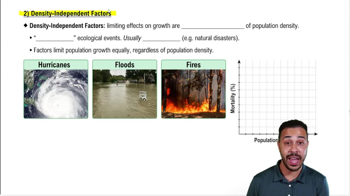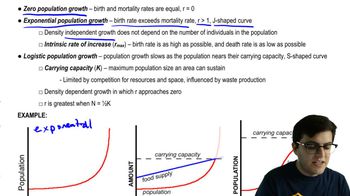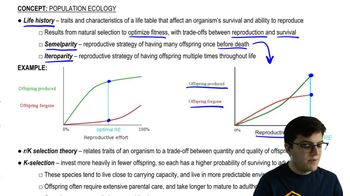Table of contents
- 1. Introduction to Biology2h 40m
- 2. Chemistry3h 40m
- 3. Water1h 26m
- 4. Biomolecules2h 23m
- 5. Cell Components2h 26m
- 6. The Membrane2h 31m
- 7. Energy and Metabolism2h 0m
- 8. Respiration2h 40m
- 9. Photosynthesis2h 49m
- 10. Cell Signaling59m
- 11. Cell Division2h 47m
- 12. Meiosis2h 0m
- 13. Mendelian Genetics4h 41m
- Introduction to Mendel's Experiments7m
- Genotype vs. Phenotype17m
- Punnett Squares13m
- Mendel's Experiments26m
- Mendel's Laws18m
- Monohybrid Crosses16m
- Test Crosses14m
- Dihybrid Crosses20m
- Punnett Square Probability26m
- Incomplete Dominance vs. Codominance20m
- Epistasis7m
- Non-Mendelian Genetics12m
- Pedigrees6m
- Autosomal Inheritance21m
- Sex-Linked Inheritance43m
- X-Inactivation9m
- 14. DNA Synthesis2h 27m
- 15. Gene Expression3h 20m
- 16. Regulation of Expression3h 31m
- Introduction to Regulation of Gene Expression13m
- Prokaryotic Gene Regulation via Operons27m
- The Lac Operon21m
- Glucose's Impact on Lac Operon25m
- The Trp Operon20m
- Review of the Lac Operon & Trp Operon11m
- Introduction to Eukaryotic Gene Regulation9m
- Eukaryotic Chromatin Modifications16m
- Eukaryotic Transcriptional Control22m
- Eukaryotic Post-Transcriptional Regulation28m
- Eukaryotic Post-Translational Regulation13m
- 17. Viruses37m
- 18. Biotechnology2h 58m
- 19. Genomics17m
- 20. Development1h 5m
- 21. Evolution3h 1m
- 22. Evolution of Populations3h 52m
- 23. Speciation1h 37m
- 24. History of Life on Earth2h 6m
- 25. Phylogeny2h 31m
- 26. Prokaryotes4h 59m
- 27. Protists1h 12m
- 28. Plants1h 22m
- 29. Fungi36m
- 30. Overview of Animals34m
- 31. Invertebrates1h 2m
- 32. Vertebrates50m
- 33. Plant Anatomy1h 3m
- 34. Vascular Plant Transport2m
- 35. Soil37m
- 36. Plant Reproduction47m
- 37. Plant Sensation and Response1h 9m
- 38. Animal Form and Function1h 19m
- 39. Digestive System10m
- 40. Circulatory System1h 57m
- 41. Immune System1h 12m
- 42. Osmoregulation and Excretion50m
- 43. Endocrine System4m
- 44. Animal Reproduction2m
- 45. Nervous System55m
- 46. Sensory Systems46m
- 47. Muscle Systems23m
- 48. Ecology3h 11m
- Introduction to Ecology20m
- Biogeography14m
- Earth's Climate Patterns50m
- Introduction to Terrestrial Biomes10m
- Terrestrial Biomes: Near Equator13m
- Terrestrial Biomes: Temperate Regions10m
- Terrestrial Biomes: Northern Regions15m
- Introduction to Aquatic Biomes27m
- Freshwater Aquatic Biomes14m
- Marine Aquatic Biomes13m
- 49. Animal Behavior28m
- 50. Population Ecology3h 41m
- Introduction to Population Ecology28m
- Population Sampling Methods23m
- Life History12m
- Population Demography17m
- Factors Limiting Population Growth14m
- Introduction to Population Growth Models22m
- Linear Population Growth6m
- Exponential Population Growth29m
- Logistic Population Growth32m
- r/K Selection10m
- The Human Population22m
- 51. Community Ecology2h 46m
- Introduction to Community Ecology2m
- Introduction to Community Interactions9m
- Community Interactions: Competition (-/-)38m
- Community Interactions: Exploitation (+/-)23m
- Community Interactions: Mutualism (+/+) & Commensalism (+/0)9m
- Community Structure35m
- Community Dynamics26m
- Geographic Impact on Communities21m
- 52. Ecosystems2h 36m
- 53. Conservation Biology24m
50. Population Ecology
Introduction to Population Ecology
Problem 9a
Textbook Question
The current carrying capacity of Earth for the human population may have been inflated by . a. demographic momentum; b. the tendency for women to want to control family size; c. an artificially low number of density-independent factors; d. our use of fossil fuels; e. recent population crashes
 Verified step by step guidance
Verified step by step guidance1
Identify the key term in the question: 'current carrying capacity of Earth for the human population'. This refers to the maximum number of individuals that the Earth can support sustainably without degrading the environment.
Understand that the question is asking which factor might have caused an overestimation of this carrying capacity.
Analyze each option: a) Demographic momentum refers to the lag between changes in fertility rates and their effect on population size. b) The tendency for women to want to control family size could influence birth rates. c) An artificially low number of density-independent factors would not directly inflate carrying capacity estimates. d) The use of fossil fuels has allowed human populations to utilize more resources and technology to support larger populations. e) Recent population crashes would typically lower estimates of carrying capacity, not inflate them.
Consider which option most directly relates to an increase in the Earth's ability to support a larger population temporarily or artificially.
Conclude that the option which best fits the description of inflating Earth's carrying capacity by providing additional, albeit unsustainable, support to human populations is the one related to an external input that boosts human capacity beyond what the natural environment can sustain.
Recommended similar problem, with video answer:
 Verified Solution
Verified SolutionThis video solution was recommended by our tutors as helpful for the problem above
Video duration:
2mPlay a video:
Was this helpful?
Key Concepts
Here are the essential concepts you must grasp in order to answer the question correctly.
Carrying Capacity
Carrying capacity refers to the maximum number of individuals of a species that an environment can sustainably support without degrading the habitat. For humans, this concept is influenced by resource availability, technology, and consumption patterns. Understanding carrying capacity is crucial for evaluating the sustainability of human populations and their impact on the planet.
Recommended video:
Guided course

Estimating Earth’s Human Carrying Capacity
Demographic Momentum
Demographic momentum is the phenomenon where a population continues to grow even after fertility rates decline, due to a large proportion of individuals in reproductive age. This can lead to an inflated perception of carrying capacity, as the population may still increase despite efforts to control growth. Recognizing demographic momentum is essential for understanding population dynamics and future projections.
Recommended video:
Guided course

Population Demography
Density-Independent Factors
Density-independent factors are environmental influences that affect population size regardless of the population's density, such as natural disasters, climate change, and resource availability. These factors can significantly impact the carrying capacity of an environment by altering the conditions under which populations thrive. Understanding these factors helps in assessing the resilience and sustainability of human populations.
Recommended video:
Guided course

Density-Independent Factors

 1:17m
1:17mWatch next
Master Population Ecology with a bite sized video explanation from Jason Amores Sumpter
Start learningRelated Videos
Related Practice



































































